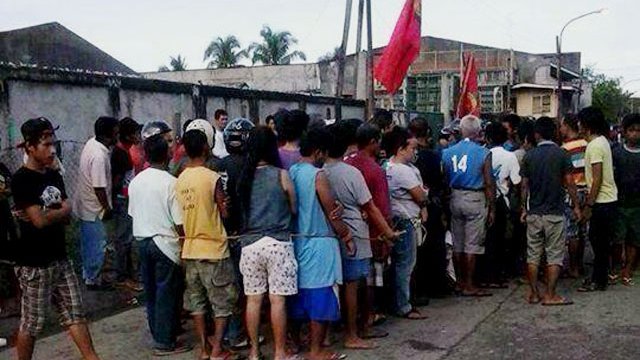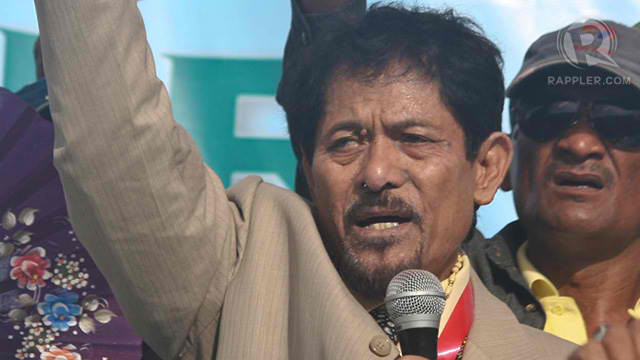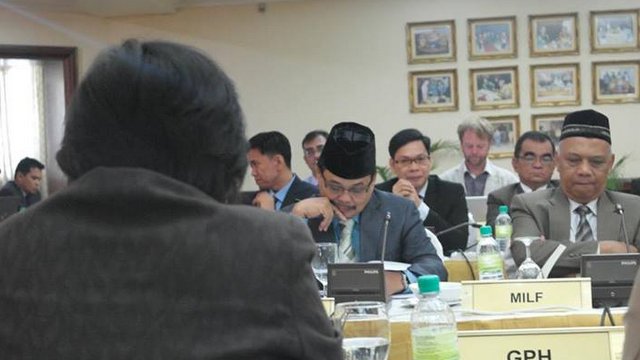SUMMARY
This is AI generated summarization, which may have errors. For context, always refer to the full article.

MANILA, Philippines – It’s an incident that best illustrates the animosity between the Moro National Liberation Front (MNLF) and its rival organization, the Moro Islamic Liberation Front (MILF).
At a meeting called by the Organization of Islamic Cooperation (OIC) in Djibouti, Africa in November 2012, MNLF founding chairman Nur Misuari told OIC officials that the rogue MILF faction, the Bangsamoro Islamic Freedom Fighters, and its leader Umra Kato are a “million times more important than the people here.”
By “people here” Misuari meant MILF chairman Al Haj Murad Ebrahim and key MILF leaders who were in the same meeting. (Kato’s forces, who broke away from the MILF over serious disagreements on the peace process, are said to be behind the spate of bombings in Central Mindanao in July and August.)
The account of what happened at the OIC meeting was published in August on www. luwaran.com, the official website of the MILF.
The MILF leaders present at the OIC meeting chose not to confront Misuari and they just “let the sour-graping pass,” the Luwaran story said.
An influential body of at least 56 Islamic countries, the OIC has played a key role in persuading the MNLF to talk peace as early as 1976 — under the Marcos regime. Being the first Muslim rebel movement in the Philippines, the MNLF had a headstart in getting OIC legitimacy; the MILF was always considered as the poor cousin — until now.
Is it far-fetched to suspect that Misuari’s loyalists occupied villages in Zamboanga City on Monday, September 9, to spite the poor cousin?
Sabotage the talks
Rommel Banlaoi, executive director of the Philippine Institute for Peace, Violence, and Terrorism Research, said the Zamboanga attack was meant to sabotage the peace talks between the Aquino government and the MILF, which is now on its final round.
“Misuari’s motive is to convey a message… (that) the signing of the peace agreement between the government and the MILF will no longer guarantee the end of war,” Banlaoi told Agence France-Presse Monday.
Despite the attack that caught government flat-footed, the MNLF is now just a shadow of its former self.
Wounded by divisions caused largely by the other leaders’ unhappiness with Misuari, the MNLF is composed of at least 3 factions. One is led by Misuari and is referred to by authorities as the “MBG,” or the Misuari Breakaway Group, while the second faction is led by Habib Mujahab “Boghdadi” Hashim, chairman of an MNLF breakaway faction, the Islamic Command Council. Both are opposed to the government-MILF peace talks.
Another faction, led by former Cotabato City Mayor Muslimin Sema, is supportive of the MILF negotiations.
In 1996, Misuari, on behalf of the MNLF, signed a final peace agreement with the Ramos government. It allowed qualified MNLF members to enter the military and the police force, or surrender their arms in exchange for a sum of money. It created the Southern Philippines Council for Peace and Development, that was packed with MNLF leaders and members. It paved the way for Misuari to run unopposed as governor of the Autonomous Region in Muslim Mindanao.
It was for peace, Misuari said then. It was a sellout, his critics within the organization countered.
That year, the MILF, which had long broken away from the MNLF, also entered into informal talks with the Ramos government. But the MILF peace project was put on the back burner, allowing the organization to recruit, establish huge camps in Central Mindanao and become the biggest Muslim rebel movement.
Former President Joseph Estrada took a hardline position against the MILF and deployed the military to crush Camp Abubakar, the MILF headquarters. His successor, Gloria Macapagal-Arroyo, attempted to sign a peace pact with it, but her plan was shot down as unconstitutional by the Supreme Court.
After President Benigno Aquino III assumed power in 2010, he went out of his way to meet with Murad in Tokyo. Months later, the government and the MILF signed the 2012 Framework Agreement that set the parameters for a comprehensive peace process that both sides hope to end this year.
READ: The Framework Agreement between the gov’t and the MILF
Misuari felt betrayed, calling the MILF “traitors,” since there was still an ongoing review of the 1996 peace agreement for its unimplemented provisions.
READ: Dealing with an angry Misuari
Misuari’s frustrations reached fever pitch when news spread that the government had sought the “termination” of the MNLF peace pact.
It turned out, as what senior adviser to the MNLF peace process Joe Lorena has said, the government only wanted to conclude the ongoing tripartite review of the peace pact, not the agreement itself.
Feeling left out in the ongoing peace talks, Misuari wanted the government to re-open negotiations with the MNLF. But the government has maintained there is no need to do so since the Bangsamoro Basic Law, which will provide the legal framework for the proposed Bangsamoro political entity, will address the “issues” being raised by the MNLF.
And to address the MNLF’s pending concerns, the government, the MNLF and Indonesia – in its capacity as the chair of the OIC-Peace Committee for Southern Philippines (OIC-PCSP) – is conducting a tripartite review of the 1996 peace accord.
The talks, which began in November 2007, have produced a document known as the 42 consensus points, a list of issues where all sides try to find common ground.
Rappler requested for a copy of the document more than a month ago but the Office of the Presidential Adviser on the Peace Process has yet to release it. Undersecretary Joe Lorena’s office said it is still being screened because it contains “sensitive” information.
Another triparte review is set to be held on September 16 to 17 in Indonesia, but with the siege in Zamboanga, it remains unclear whether this would push through.

Pending issues
What are the issues that Misuari wants to renegotiate?
In an earlier interview with Rappler, Lorena said the 3 main issues are:
- The expansion of ARMM territory through a plebiscite
- The establishment of a provisional government
- Issues on wealth-sharing
Lorena said these 3 issues were not originally part of the tripartite review. Of the 3 issues, Lorena said 2 had already been implemented as far the government is concerned.
For instance, the expansion of ARMM’s territory was already implemented in a plebiscite in 2002, wherein Marawi City and Basilan opted to be included in the region.
The establishment of a provisional government was already fulfilled through the Southern Philippines Council for Peace and Development, an interim body for the Special Zone of Peace and Development that was set up after the signing of the 1996 agreement.
The issue of wealth-sharing in strategic resources, on the other hand, is already covered by the wealth-sharing deal signed by the MILF and the government in July 2013. “In effect, the wealth-sharing is achieved through MILF,” Lorena explained.
The government expects the issues being raised by the MILF in the current talks and by the MNLF in the tripartite review to come together through the Bangsamoro Basic Law.
However, the MNLF opted not to join the Transition Commission, which is tasked to draft the law, despite an invitation from the government.
Instead of pushing for the tripartite talks to continue, Misuari declared “independence” for the so-called Bangsamoro Republik in July.

Inclusive
Still, the government and the MILF remain hopeful Misuari will agree to be on board, especially since the Bangsamoro peace agreement is designed to be “inclusive.”
MILF vice chairman for political affairs Ghadzali Jaafar said no one’s stopping Misuari from running to become the head of the proposed entity.
“As a matter of fact, under the proposed Bangsamoro Basic Law, if it is finished, one of its provisions is to provide for an electoral exercise, which of course any qualified Bangsamoro leader who want to run [could join]… and that includes Brother Nur Misuari,” Jaafar said. “You see, if he can run he can even become the first ‘chief minister’ of the Bangsamoro government. That’s why we have always been saying that we should give these negotiations a chance. If the Bangsamoro people want him, why not?”
But what are the chances that Misuari will have a change of heart?
As the secretary-general of another MNLF faction, Abdul Sahrin, told ABS-CBN, the Zamboanga City siege is not about independence. It’s about power.
Another MNLF leader, Boghdadi Hashim agrees.
“I believe the only possible idea is to show to the whole government that the MNLF is still a force to be reckoned with, unlike what they are saying on the other side that the MNLF is a spent force, that the MNLF can’t fight anymore,” Hashim earlier said.
In radio interviews, Misuari’s spokesperson Emmanuel Fontanilla said MNLF’s issue is political, not military.
And there might be other implications, analyst Banlaoi told Agence France-Presse: “The fear now is Misuari could create one united front along with other threat (armed) groups against the Philippines.”
Appeal
Taking a page out of the past, the government and the MILF are careful not to fall into the same problematic arrangements that the Ramos government and the MNLF entered into, as they thresh out the remaining details on how power will be shared between the Bangsamoro and the central government, as well as how the situation in the region will be normalized.
READ: Gov’t, MILF gear up for ‘final’ round of talks
MILF chief negotiator Mohagher Iqbal has always said that the MILF is pushing for an agreement that provides for “full autonomy, short of independence.”
Whether the expected peace agreement on the Bangsamoro will be “better” than the 1996 peace agreement between the Ramos government and the MNLF is not the issue, the MILF said in a September 8 editorial on Luwaran.
“Whoever has the right formula, we firmly subscribe to it. Individuals or leaders can only be good up to a certain period; after that, he has to go – if possible, for good.”
For both sides, Lorena has an appeal:
“The MILF and the MNLF are just vanguards of the Bangsamoro people and therefore the issues that have been lodged in both panels are issues which are Bangsamoro issues. Therefore, to complete the process, they must [put the people first].” – Rappler.com
Add a comment
How does this make you feel?
There are no comments yet. Add your comment to start the conversation.